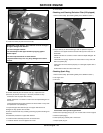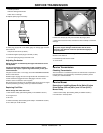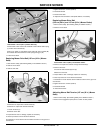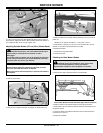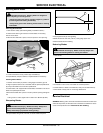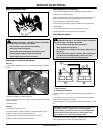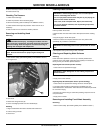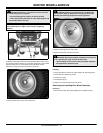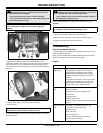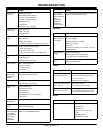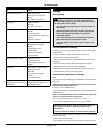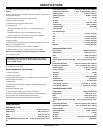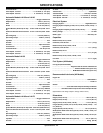
Service Miscellaneous - 37
SERVICE MISCELLANEOUS
5. Start the engine of the disabled machine and run machine for several
minutes.
6. Carefully disconnect the booster cables in the exact reverse order:
negative cable first and then the positive cable.
Replacing Headlight Bulb
1. Park machine safely. (See Parking Safely in the SAFETY section.)
2. Lift hood.
MX17057
3. Turn bulb socket (A) 1/4 turn counterclockwise to remove.
4. Replace defective bulb with a new bulb.
5. Insert bulb socket into housing, push in and turn 1/4 turn clockwise to
install.
6. Lower hood.
Replacing Fuse
1. Park machine safely. (See Parking Safely in the SAFETY section.)
2. Lift hood.
MX16570
3. Pull defective fuse (A) out of socket.
4. Check metal clip in fuse window and discard fuse if clip is broken.
5. Push new 20 amp fuse into socket.
6. Lower hood.
Service Miscellaneous
Using Proper Fuel
Use regular grade unleaded fuel with an octane rating of 87 octane or
higher. Fuel blends containing up to 10% ethanol or up to 15% MTBE
reformulated fuel are acceptable. Do not use fuel or additives containing
methanol as engine damage can occur.
Always use fresh, clean fuel that is purchased in a quantity that can be
used within approximately 30 days, or add fuel stabilizer.
Fuel is blended to give best seasonal performance. To avoid engine
performance problems such as hard starting or vapor lock, use in-season
fuel. Use fuel during warm weather that was purchased during that
season, and use fuel during cold weather that was purchased during that
season.
Fuel can become stale in machines with engines that are used seasonally
or infrequently during a season. Stale fuel can produce varnish and plug
carburetor components which can affect engine performance.
Keep fuel storage container tightly covered and in a cool area out of direct
sunlight. Fuel can break down and degrade if not sealed properly or
exposed to sun and heat.
Condensation may collect in the fuel tank because of a variety of operating
or environmental conditions and, over time, may affect your machine’s
operation. Fill fuel tank at the end of daily use and store fuel in plastic
containers to reduce condensation.
For best year-round performance and fuel-handling, add stabilizer to fuel
immediately after fuel purchase. Such practice helps prevent engine
performance problems and allows fuel storage in the machine all year
without draining.
Filling Fuel Tank
Fill fuel tank at the end of each day’s operation to prevent condensation
and freezing during cold weather.
1. Park machine safely. (See Parking Safely in the SAFETY section.)
2. Allow engine to cool.
3. Remove any trash from area around fuel tank cap.
4. Remove fuel tank cap slowly to allow any pressure built up in tank to
escape.
A
A
c CAUTION: Avoid injury! Fuel vapors are explosive and
flammable:
• Shut engine off before filling fuel tank.
• Allow engine to cool before refueling.
• Do not smoke while handling fuel.
• Keep fuel away from flames or sparks.
• Fill fuel tank outdoors or in well ventilated area.
• Clean up spilled fuel immediately.
• Use clean approved non-metal container to prevent static
electric discharge.
• Use clean approved plastic funnel without screen or filter to
prevent static electric discharge.
IMPORTANT: Avoid damage! Dirt and water in fuel can cause
engine damage:
• Clean dirt and debris from the fuel tank opening.
• Use clean, fresh, stabilized fuel.
• Fill the fuel tank at the end of each day’s operation to keep
condensation out of the fuel tank.
• Use a non-metallic funnel with a plastic mesh strainer when
filling the fuel tank or container.



